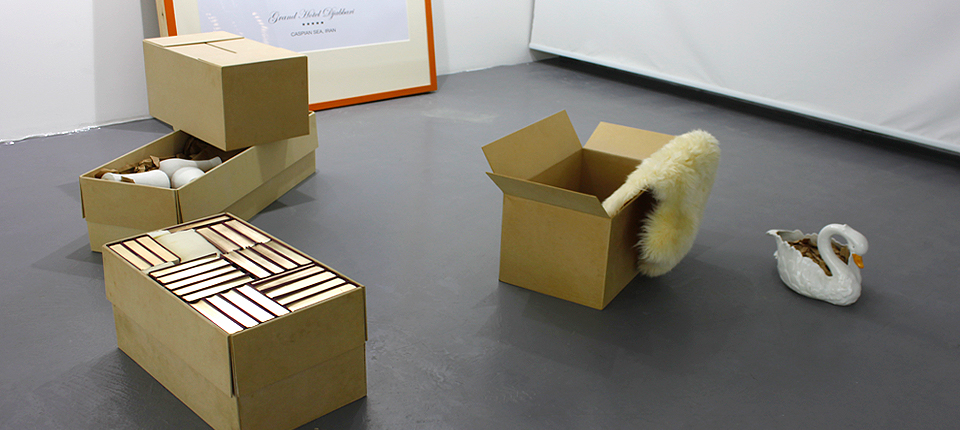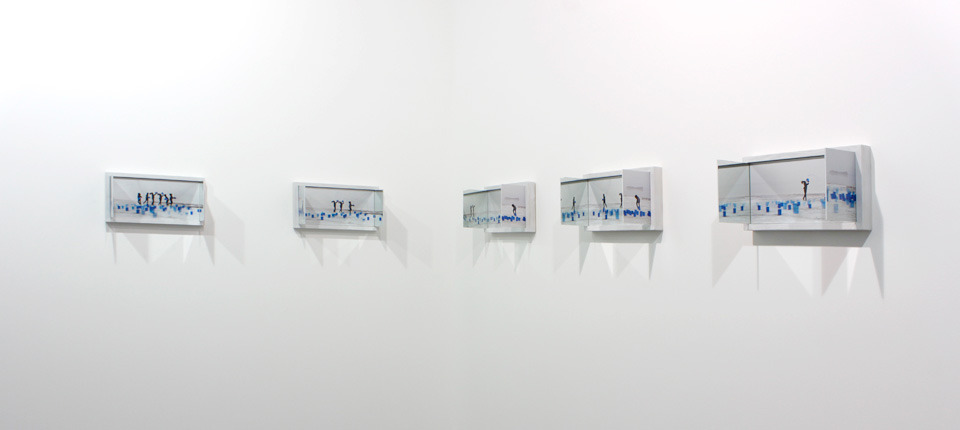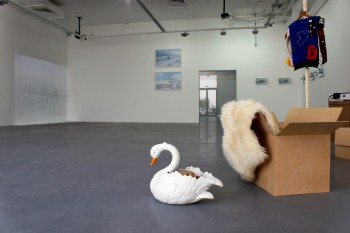Exhibition VII
From Outside or Otherwise: Neda Zarfsaz and Claudia Parwaneh Djabbari
The exhibition, From Outside or Otherwise, at Mottahedan Projects, Dubai, presents a pairing of the young artists, Neda Zarfsaz and Claudia Parwaneh Djabbari. Taken from a Platonic principle set forth in the Republic that stresses subjectivity and the impossibility of gaining complete knowledge from an exterior vantage point, the title encourages the viewer to leave the outside or otherwise and enter a shared space that envisions an expanded human condition unbound by decay and time.
Claudia Djabbari’s Grand Hotel Djabbari uses Iran’s natural landscape as means by which to address the cyclic movement of construction, reconstruction and destruction. Djabbari drew upon travel guides, illustrated books and stories about the so-called Persian Riviera to create this architectural model of an imagined resort hotel by the Caspian Sea. Created according to international market standards for upscale hotels, the mock-up loops fantasy and reality as it posits an impossible dream given current geopolitical circumstances. Confusing documentation with narration, this utopia is at once present and unreachable.
Rendered as a typical resort in an Orientalized style that recalls a history of European exploration of the Near East, the ‘hotel’—or rather, its representation—exists in a fantastic space that sharply contrasts with the current Iranian context. Hotel Djabbari serves as a dream evoking beauty and implying the fulfillment of desire; yet, as the symbol of an idealized past that must crumble in the face of present-day realities, this holiday paradise transforms into a paradise lost.
The installation, In Storage, instead captures an ambiguous moment in which it is not clearly whether a room is about to be furnished or is in the process of being dismantled. Fantasy and mystery define this work that exists in the interregnum and is neither here nor there, neither past nor present—or perhaps, rather, all these things at once. In its paradox and exit from conventional temporal linearity, the work is nostalgic, mystical and poetic.
Chichast, a series by Iranian artist Neda Zarfsaz derives its title from the ancient name for Lake Urmia in northwestern Iran. Translated as ‘glittering’, Chichast references to the lake’s salt deposits. For centuries, the lake has played a role in the Iranian consciousness as it weaves through myths and legends and its shore-side mud is attributed with healing powers. In recent years, drought and over-irrigation have caused depletion of the lake’s waters, threatening its wildlife.
In this series, which depicts photographs of the artist dumping bottomless buckets of water into the lake in attempt to reverse that trend as well as landscape photographs displayed in glass boxes containing salt, Zarfsaz appears as an individual confronted with realities larger than herself. As she futilely attempts to resuscitate life, the artist’s initiative calls for human responsibility to the environment and other species in the global community. The salt-filled cases, which configure the works as hourglasses, maintain the immediacy of time and the pressures of acting against the clock—i.e., before death overtakes life.
The force of these works lies in their conceptual simplicity: they are just as they are staged. In a return to premodern concerns, the works suggest the priority of object over form as the material (water)—not its presentation—constitutes the works’ primary meaning. Collapsing art and action, Zarfsaz’s performances combine works of art with the less romantic work of physical labour and fulfilling a duty.
Zarfsaz’s video, The Notion of Reason, also presents the value of assiduity and persistence. In the video, Zarfsaz performs a children’s game played in Iran in which girls repeatedly thread a string through the skin or their palms until one child’s thread breaks and she loses. Inspiring visceral reactions, the game seems like a masochistic endeavor, even though, in actuality, the artist experiences no pain the string is in fact only threaded to the outermost, nerveless layer of skin. Thus, the piece opens a conversation about the oppressive condition of women but optimistically concludes that the individual may nonetheless ‘win’ at a game in which she finds herself caught, subject to rules she had no hand in writing.
Both Zarfsaz and Djabbari present the complexity of how we relate to space. Configuring space as collective memory and vice versa, they prove that imagination can be limited and faulty yet also pose alternative, brighter possibilities. In a global context in which artists everywhere face restrictions on freedom of expression, works like those of Zarfsaz and Djabbari offer points of refuge, havens in which vision might overtake eventuality.
Claudia Djabbari was born in 1976 in Munich, Germany. She holds an MFA in Fine Arts from Goldsmiths, University of London, which she completed after studying theatre design at the Mozarteum in Salzburg, Austria, and Fine Art at the Akademie der Bidenden Künste in Munich. Her solo exhibitions include Migration of Dreams at Haleh Gallery in Berg, Germany, and Perserbilder at Akademiegalerie in Munich, Germany. Recently, group exhibitions in which her work has appeared include Summer Show at Cul de Sac Gallery in London (2013); residency exhibition projects at Norrköping Konstmuseum in Norrköping, Sweden, and in Mumbai, India (both 2013); Constructed Scenario at The Third Space / Wilkes Street Space in London (2012); Unconscious Architecutre at Visual Artist’s Association Nicosia in Nicosia, Cyprus (2012); London-Munich at Cul de Sac Gallery in London (2012); and Winter Pavillion at Waterside Contemporary in London (2012). Djabbari lives and works between Munich and London.
Neda Zarfsaz was born in 1981 in Urmia, Iran. She holds an MFA from C:Art:Media, Valand School of Fine Arts, Gothenburg University, in Gothenburg, Sweden (2011), and a BA in Visual Communication Design, Art faculty of Alzahra University, in Tehran, Iran (2008). In 2013, she was awarded the Magic of Persia Gasworks residency in London. Her most recent group exhibitions include Surveiling the Naked City: Video Art from Tehran at Atopia in Oslo, Norway (2013); Drawing Week 1 at Homa Art Gallery in Tehran (2013); Kunstort ‘inbetween’ in Gelsenkirchen, Germany (2012); La Turo de Babel at Galleri Rotor in Gothenburg, Sweden (2012); Time’s Memory Remembrance of Objects: Video Art at Mohsen Gallery in Tehran (2012); and Photography Show at Mohtasham Art Gallery in Urmia, Iran (2012). Zarfsaz lives and works in Tehran.










